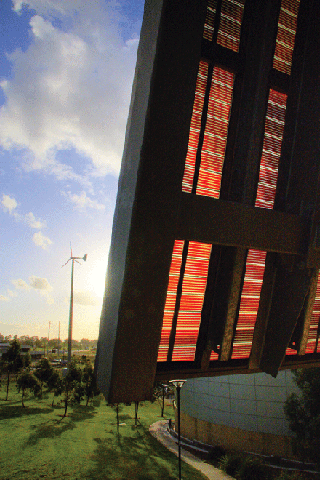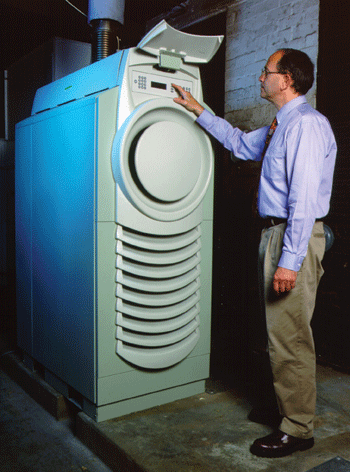
|
Published:
Power to the people
A new report from CSIRO shows that by adopting low-emission distributed energy, Australia could reduce its greenhouse emissions, save water, and save $130 billion as it moves to a low-carbon economy by 2050. And the good news is that all this can be done using technology that is available now.

|
|
Solar power is expected to be one of the main local energy sources for distributed energy networks. Credit: CSIRO
|
With a high proportion of electricity lost in transmission over the often-large distances from centralised power stations to end-user, it’s no wonder that the prospect of decentralising the grid and switching to local energy sources is gaining support. This new energy paradigm is known as ‘distributed energy’ (DE).
‘Distributed energy is a term used to describe the systems and technologies that provide local power generation, energy efficiency and demand management; that is, the management of when and how energy is used,’ says Anthony Szatow, Program Leader of the Intelligent Grid and Low Emissions Distributed Energy themes of the Energy Transformed Flagship.
A wide range of DE low-emission local energy options are available, offering an immediate, cost-effective response to climate change. DE systems could include gas-fired cogeneration plants or roof-mounted photovoltaic cells, more efficient heating and cooling systems, or electricity load management devices that balance out energy demand and supply.
CSIRO’s 600-page report, Intelligent Grid: A value proposition for wide-scale distributed energy solutions in Australia, used economic modelling and simulation to exhaustively examine the social, technological, environmental and economic value of widespread DE use in Australia.
DE is not to be confused with smart grid technologies or smart meters that are being rolled out by various state governments and electricity suppliers, although these may later become an important component of integrating distributed energy systems with the electricity grid.
‘We knew it was physically possible to reduce emissions in line with the Garnaut scenario of global stabilisation at 450 ppm atmospheric CO2, but at what cost?’ says Szatow.
‘We created models of the energy sector with different combinations of rural, residential, commercial and industrial users, and asked those models to meet the Garnaut scenario with and without DE and then compared the difference in total energy consumed and its price.
‘We found that cost savings associated with wide-scale DE use could be as large as $130 billion. We also found that water used for electricity generation can be reduced by as much as 75 per cent through a combination of DE technology and large-scale renewables such as wind farms and solar plants.’
Szatow says he expects the different types of DE generation technologies to differ in importance over time, with gas-fired cogeneration, biomass cogeneration and trigeneration becoming increasingly important over the next three to five years. Trigeneration is the simultaneous production of mechanical power, heat and cooling from a single heat source. As with cogeneration, waste heat from power generation is harnessed, increasing system efficiency. In the longer term, however, solar power is expected to be the greatest contributor to DE generation.
‘The big savings are possible because it is easier and cheaper to be more energy efficient than to supply additional energy, which requires the construction of new power plants, equipment and grid infrastructure,’ says Szatow.
A big part of the DE concept is energy efficiency and energy management, he adds, saying that more efficient building design, improved heating and cooling systems, water heating, and lighting are expected to be the largest contributors to reduced emissions.
Even so, Szatow says that an effective DE network is feasible now, without significant changes to the grid. ‘We expect around 20–30 per cent of energy can be supplied locally before facing technical issues in the electricity network.’
Intelligent Grid also looked at other factors relevant to energy market stakeholders, including the role of policy-makers, regulators, distribution companies, energy retailers and consultants, communities, academics and consumers. Szatow says the report found that long-term policy and regulatory uncertainty, as well as a lack of understanding across the board on DE and how it works, are big issues.

|
|
Small, low-emissions local energy sources, such as microturbines, will also be a part of the DE mix. Credit: CSIRO
|
‘There is a real need for education at all levels. Many concepts have been around for a long time, but not a lot of time or effort has been put into developing skills associated with physically installing the technologies, for example.
‘It’s still an emerging industry in Australia, and stakeholders interviewed for the project suggest that this is partly related to policy uncertainty. Long-term certainty creates a smoother development of a new industry, but if the policy keeps changing, we end up with a stop-start industry.’
In Victoria’s Mount Alexander region, the intelligent grid model has already been put to the test. In 2008, supported by the local government and other businesses, the town’s four main employers (and biggest energy users) – a hospital, a food manufacturer, a carpet mill and a pump manufacturer – started looking for ways to reduce their net footprint by 30 per cent by 2010.
Dean Bridgfoot, Project Officer for the Mount Alexander Sustainability Group, a local climate action group, drove the project. ‘Essentially, all of Mount Alexander’s electricity comes from the Latrobe Valley, which has high greenhouse intensity. It also travels a long way, so there are lots of losses en route. [The project] offered a good opportunity to make some significant greenhouse savings,’ he says.
‘What made this project interesting was that we had to investigate the opportunities available in a short timeframe, and to work with existing technologies to reduce the local footprint and secure supply so that these businesses could continue to operate effectively.’
The businesses modelled different DE combinations to see what might work within the constraints and met with immediate success.
‘The food manufacturer has taken the recommendations from the project and will install 4 MW of cogeneration. Even though they are doubling their production in Castlemaine in 2010, overall they will have reduced how much carbon pollution they produce per kilogram of product by more than 30 per cent. This is a great example of what is possible,’ says Bridgfoot.
‘The hospital found more than 15 per cent savings in energy efficiency and is buying 15 per cent of its electricity from green power, and so is on target to meet its reduced emissions targets.’
The project also looked at securing supply through load shedding, where businesses collaborate and vary their production sequences, so they are not all drawing large amounts of power from the grid at the same time.
‘This helps the grid, but raises interesting questions over who pays and on what basis,’ says Bridgfoot. ‘With the help of an isolator switch and a simple protocol coordinating processes so that when the food manufacturer has its fridges switched on the pump manufacturer can’t test its pumps it is fairly easy [to manage load shedding]. But who should pay for the protocol, monitor the equipment and so on?’
This supply security benefits the grid, the energy supplier and ultimately all of the grid’s users, he continues. ‘Energy supplier Powercor can put a business case to the regulatory authority allowing them to fund this arrangement and recover their costs appropriately.
‘But they may have to wait three to four years, because of the length of Australian electricity regulatory cycles.
‘The grid needs to be more flexible, to allow service providers to be paid from discretionary funds for their demonstration of good intent and for their assets,’ he comments. ‘It is crucial to get regulations and regulatory cycles right, because at the moment they are a major impediment to DE innovation.’



